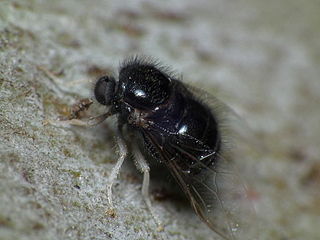
The Acroceridae are a small family of odd-looking flies. They have a hump-backed appearance with a strikingly small head, generally with a long proboscis for accessing nectar. They are rare and not widely known. The most frequently applied common names are small-headed flies or hunch-back flies. Many are bee or wasp mimics. Because they are parasitoids of spiders, they also are sometimes known as spider flies.

Acrocerinae is a subfamily of small-headed flies in the family Acroceridae. Their larvae are endoparasites of araneomorph spiders, with the exception of Carvalhoa appendiculata which can develop as ectoparasitoids on their host spiders. Traditionally, the subfamily included the genera now placed in Cyrtinae and Ogcodinae, but the subfamily in this sense was found to be polyphyletic and was split up in 2019.

Philopotinae is a subfamily of small-headed flies. They have an arched body shape, as well as enlarged postpronotal lobes that form a collar behind the head. Their larvae are endoparasites of araneomorph spiders in the subgroup Entelegynae.

Panopinae is a subfamily of small-headed flies (Acroceridae). Their larvae are endoparasites of spiders in the infraorder Mygalomorphae.
Coquena is a genus of small-headed fly found in Argentina and Chile. It was first established by Evert I. Schlinger in 2013.
Pialea is a genus of small-headed flies. It is known from South America.

Ogcodes is a cosmopolitan genus of small-headed flies in the family Acroceridae. About 90 species have been described for the genus. It is the most common and speciose genus in its family. These flies are endoparasitoids of ground-dwelling entelegyne spiders.
Archocyrtus is an extinct genus of small-headed flies in the family Acroceridae. The genus is known from compression fossils from the Late Jurassic Karabastau Formation of Kazakhstan. The genus is the only member of the subfamily Archocyrtinae.
Glaesoncodes is an extinct genus of small-headed flies in the family Acroceridae. It is known from Baltic amber from the Eocene, though the locality is unknown. It contains only one species, Glaesoncodes completinervis.

Schlingeromyia is an extinct genus of small-headed flies in the family Acroceridae. The genus is known from Upper Cretaceous fossils in Burmese amber from Myanmar. It contains only one species, Schlingeromyia minuta.
Villalites is an extinct genus of small-headed flies in the family Acroceridae. It is known from Baltic amber from the Eocene, though the locality is unknown. It contains only one species, Villalites electrica.
Carvalhoa is a genus of small-headed flies in the family Acroceridae. The genus is endemic to Chile. It was originally known as Sphaerops, named by Rodolfo Amando Philippi in 1865. This name was found to be preoccupied by the reptile genus Sphaerops Gray, 1845, so it was renamed to Carvalhoa by Ahmet Ömer Koçak and Muhabbet Kemal in 2013. The genus is named after the Brazilian dipterist Claudio José Barros de Carvalho.
Archaeterphis is an extinct genus of small-headed flies in the family Acroceridae. It is known from Baltic amber from the Eocene, though the locality is unknown. It contains only one species, Archaeterphis hennigi.
Eulonchiella is an extinct genus of small-headed flies in the family Acroceridae. It is known from Baltic amber from the Eocene, though the locality is unknown. It contains only one species, Eulonchiella eocenica.
Prophilopota is an extinct genus of small-headed flies in the family Acroceridae. It is known from Baltic amber from the Eocene.
Quasi is a genus of small-headed flies in the family Acroceridae. It contains only one species, Quasi fisheri, known only from Veracruz, Mexico.
Schlingeriella is a genus of small-headed flies. It contains only one species, Schlingeriella irwini, endemic to New Caledonia.

Panops is a genus of small-headed flies. It is endemic to Australia and the Papua region of Indonesia. Males and females measure 8.0–12.5 mm and 9.5–14.5 mm, respectively. Their larvae are thought to be endoparasites of spiders in the infraorder Mygalomorphae, a trait shared by most other members of the subfamily Panopinae.

Sabroskya is a genus of small-headed flies in the family Acroceridae. It is known from South Africa and Malawi. It is named after the American entomologist Curtis Williams Sabrosky.

Cyrtinae is a subfamily of the Acroceridae. Their larvae are endoparasites of araneomorph spiders in the subgroup Entelegynae.









